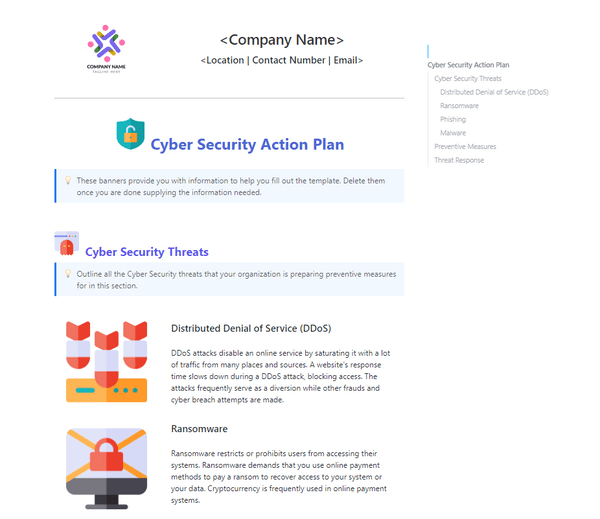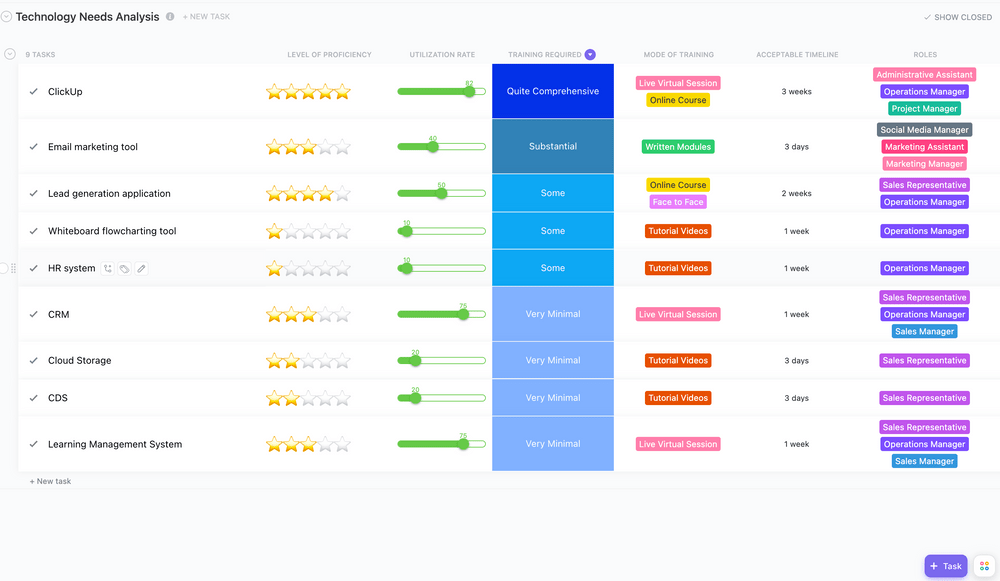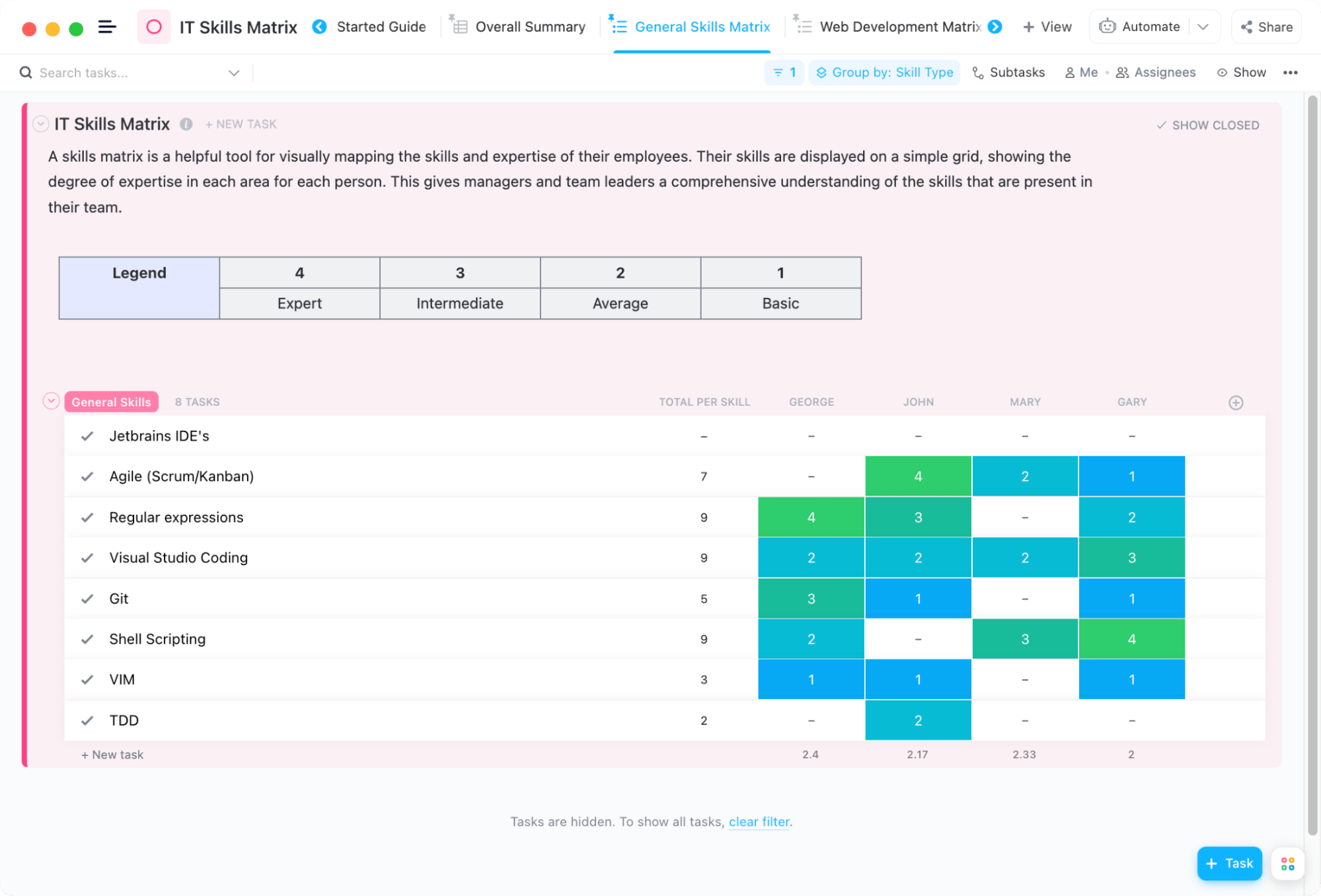In the intricate journey that is information technology (IT), having a clear direction is a must. A rough business plan or broad goals for your IT department can only take you that far. Whether you are an IT manager or a business director, you need well-defined goals to know exactly where your team needs to go and how to get there.
Having a measurable or manageable goal set for your IT team can transform your performance from satisfactory to excellent, giving your business leverage in any competitive industry. This ensures the time and efforts of your IT team are used efficiently, problems are addressed quickly, and everyone is satisfied—from business leaders to individual IT staff members. 🔥
In this article, we’ll learn more about IT goals and objectives, short-term and long-term. We’ll cover:
- 10 IT goals aligned with your current IT systems
- Common KPIs to measure the progress of your IT department
- The process of creating defined goals and tracking them with tools like ClickUp, a project management solution for IT teams
- What Are IT Goals?
- What Are the Benefits of Setting Strategic Goals for Your IT Team?
- 10 Ambitious IT Goals to Gain Competitive Advantage in 2024
- 1. Automation and efficiency to optimize business processes
- 2. Enhance collaboration efforts to simplify your IT department’s life
- 3. Tech stack reassessment to sharpen your business strategy
- 4. Cybersecurity fortification with cutting-edge technology
- 5. IT infrastructure and enterprise architecture upgrade
- 6. Reduce costs to achieve financial business goals
- 7. Invest in talent development to keep teams motivated and competitive
- 8. Software quality and deployment
- 9. Continuous improvement and innovation for the whole business
- 10. Sustainability as part of your long-term IT objectives
- IT KPI Metrics to Track Alongside IT Department’s Goals
- How to Set and Track IT Goals with ClickUp
What Are IT Goals?
IT goals are specific business objectives that aim to upgrade and enhance the operations within an organization’s IT department. Usually, they’re part of the IT governance framework, aligning with and supporting the organization’s broad goals.
For example, as your competitors slip ahead by adopting new technologies, improving operational efficiency becomes one of your organization’s high-level business objectives. A part of the defined IT goals here may be to implement pro-efficiency IT tools to automate tasks and streamline workflows. 🛠️
It’s important that your IT department’s goals align with the overarching business objectives. In our previous example with efficiency, the broad department-level goal could be to create IT process maps and find opportunities for automating tasks.
Goal setting is effective only when accompanied by defined timeframes and key performance indicators (KPIs) to measure success. That’s why many IT leaders use the SMART goals framework for goal setting, where SMART is an acronym that describes goals as:
- Specific
- Measurable
- Attainable
- Relevant
- Time-bound
It’s also important to estimate the effort and value your IT goals bring so you can prioritize plans that have the biggest measurable impact on the organization.
Bonus tip: Create SMART goals for your information technology teams by using the free ClickUp SMART Goal Action Plan Template. It offers an excellent framework for creating defined IT goals and achievable tasks, with built-in tools to track milestones.
Check out more goal setting templates!
What Are the Benefits of Setting IT Goals?
When you define and prioritize IT goals clearly, you can enjoy benefits such as:
- Organizational alignment: The IT department’s efforts contribute to the organization’s growth by helping hit targets efficiently and achieve success
- Improved decision-making: IT goals provide a reliable framework to turn to when making tough decisions for all your business needs, and more importantly, when allocating resources or revamping existing systems
- Performance evaluation: When you know what to strive for, you’ll have a reference for progress tracking, performance assessment, and detecting areas for continuous improvement
- Focus and motivation: It’s easy to get lost in mundane IT tasks and forget why you’re doing what you’re doing. IT goals provide a sense of direction and purpose, motivating teams to put in intentional work
- Competitive advantage: When work is aligned and efficient, the organization can adapt to ongoing changes and trends and have the wiggle room to innovate faster and gain momentum. This enables the company to outpace competitors and position itself as a market leader 👑
10 IT Goals Examples for IT Departments
Your IT goals should reflect the needs of your department and organization. To add to your pool of inspiration, let’s explore ten trending goals today’s IT teams focus on. 🌱
1. Automation and efficiency to optimize business processes
Led by artificial intelligence (AI) and machine learning (ML), the cutting-edge technology available today has the potential to transform how organizations operate. It’s sort of an unavoidable goal to take advantage of emerging AI/ML tech to streamline your IT operations end-to-end and reduce errors. 🤖
Keep up with technological advancements in your industry and be open to tools, like task automation software, that could optimize your workflow. The sooner you automate repetitive tasks, the more time you’ll have for other valuable work, such as innovation of IT systems and infrastructure.

For example, many businesses are now embracing ClickUp, a top-rated and free project management tool with a dedicated set of features for IT teams. The platform comes with:
- ClickUp Automations to fast-track repetitive manual tasks
- ClickUp Form Builder to collect and track bugs and issue requests
- Functionalities like Custom Fields, Sprint Points, Milestones, and Dependencies to design tailored workflows for IT departments

Furthermore, you can enjoy one of the most advanced AI assistants for IT on the platform: the ClickUp Brain. It can craft and edit IT documentation, create briefs, brainstorm project ideas, auto-fill table data, write customer emails, and summarize and translate text for you.
📮ClickUp Insight: 18% of our survey respondents want to use AI to organize their lives through calendars, tasks, and reminders. Another 15% want AI to handle routine tasks and administrative work. To do this, an AI needs to be able to: understand the priority levels for each task in a workflow, run the necessary steps to create tasks or adjust tasks, and set up automated workflows.
Most tools have one or two of these steps worked out.
However, ClickUp has helped users consolidate up to 5+ apps using our platform! Experience AI-powered scheduling, where tasks and meetings can be easily allocated to open slots in your calendar based on priority levels. You can also set up custom automation rules via ClickUp Brain to handle routine tasks. Say goodbye to busy work!
📊 Want to understand the impact on your team’s productivity? Get the full State of Workplace Communication Report.
2. Enhance collaboration efforts to simplify your IT department’s life
Remote and hybrid work cultures are the present and future of IT, but they make collaboration challenging. That’s why embracing a flexible work environment is one of the hottest IT goals today.
This mustn’t come at the expense of productivity, though.
Create an IT management culture based on self-service but also implement tools that foster effective remote communication and collaboration. 🤝
ClickUp happens to be the perfect tool for remote collaboration. It allows you to manage tasks and resources in a centralized platform, making work transparent and accessible from anywhere.
With ClickUp Whiteboards, the entire IT team can brainstorm and create roadmaps in real time. You can also communicate instantly via the ClickUp Chat view, comment threads, and @mentions without leaving the app.

It’s essential to have a comprehensive knowledge base that your IT staff can turn to at all times. Luckily, ClickUp Docs enables you to craft an engaging resource center for company wikis and standard operating procedures (SOPs). This will reduce the need for unnecessary meetings and back-and-forth, allowing everyone to focus on their work.
3. Tech stack reassessment to sharpen your business strategy
Your IT department’s needs evolve as the scale of work and data expand. A tool that was revolutionary before may become unsuitable or obsolete with the release of new tech. 📟
One of your IT goals should be to evaluate your tech stack regularly. Research emerging tech and analyze your current ecosystem to detect inefficiencies or redundancies and reduce technical debt.
Here are some helpful tips on tackling tech debt👇🏽
Instead of juggling various individual tools, you may need to implement a unified system to make your work more streamlined, scalable, and cost-effective.
Here’s an example: A comprehensive platform like ClickUp can replace multiple tools, including your task and project management software, ticketing software, customer relationship management (CRM) suite, and text editing and communication tools, among others.
4. Cybersecurity fortification with cutting-edge technology
As tech advances, so do cyber threats. If your team isn’t proactive and vigilant, the integrity and confidentiality of sensitive data may be compromised. Such a setback can have a significant impact on your IT objectives as well as the company’s reputation.
A potential goal: Implement a robust security system to keep your business safe, protect sensitive data, and ensure regulatory compliance. 🔒
See that your new IT systems involve:
- Measures such as data encryption and two-factor authentication
- Risk mitigation strategies, including backup and recovery procedures
- Regular security audits and updates
- Security awareness training
Tip: Use the ClickUp Cybersecurity Action Plan Template to organize your company-wide security strategy in an organized and flexible format.
5. IT infrastructure and enterprise architecture upgrade
IT infrastructure is the foundation of all IT work. Similarly, outdated enterprise architecture can cause issues like reduced system performance.
So, consider dedicating a significant amount of time and effort to maintaining and optimizing your IT systems. For example, more and more businesses today are migrating to cloud solutions as these tend to be:
- Scalable: They allow you to adjust resources based on demand
- Secure: They come with stringent security measures and disaster recovery solutions
- Cost-efficient: They usually have a pay-as-you-go pricing model
- Accessible: They allow you to access data from anywhere, which makes them suitable for remote teams
When migrating to a cloud, it’s important to plan and oversee the operation carefully to ensure a seamless data transfer and prevent disruptions. Use the ClickUp Technology Needs Analysis Template to add more structure to this process.
6. Reduce costs to achieve financial business goals
Be it direct instruction from senior management or an internal initiative, cost reduction is a goal IT teams come across frequently. Usually, they have to collaborate with the finance team to align the IT department’s investments with the company’s capacity and revenue targets. 💰
To reduce spending, you should first track and analyze current spending. Identify areas that entail the highest costs and trim any unnecessary expenses. Try to negotiate better deals with vendors or revise your resource allocation strategy. You can free up some resources by implementing IT automation.
With the ClickUp Finance Suite, you can easily monitor your expenses and financial deadlines, make automatic calculations based on numerical data, and track your progress toward efficient spending.
7. Invest in talent development to keep teams motivated and competitive
Talented IT professionals usually have no difficulty finding well-paying jobs, but they have to constantly upskill themselves to remain competent.
One of the critical goals for many IT departments is to reassess staff skills, identify knowledge gaps, and offer opportunities to upskill professionally. Invest in training and certification programs and conferences. That way, you can empower your IT staff to diversify their skills and stay relevant in the game.
Another advantage of training is that it relieves some of the pressure from recruiters. Instead of looking for new hires, you can focus on preparing your current employees for more daunting tasks.
Tip: Use the ClickUp IT Skills Matrix Template to visually map the skills and expertise of your current IT team, categorized by role or department, and plan training programs.
8. Software quality and deployment
If your team develops and maintains software, your goal may be to improve said software. These improvements include:
- Rolling out new features or updating current ones
- Enabling cross-platform accessibility, such as web or mobile
- Fine-tuning the user experience (UX) design
- Reduce any defects, improving the development and quality assurance processes
You can now streamline the entire development life cycle with ClickUp. Use it to build clear roadmaps, plan and track sprints, manage your backlog, and track progress. ClickUp even integrates with well-known repositories like GitHub, GitLab, and Bitbucket, allowing you to sync your work between platforms.
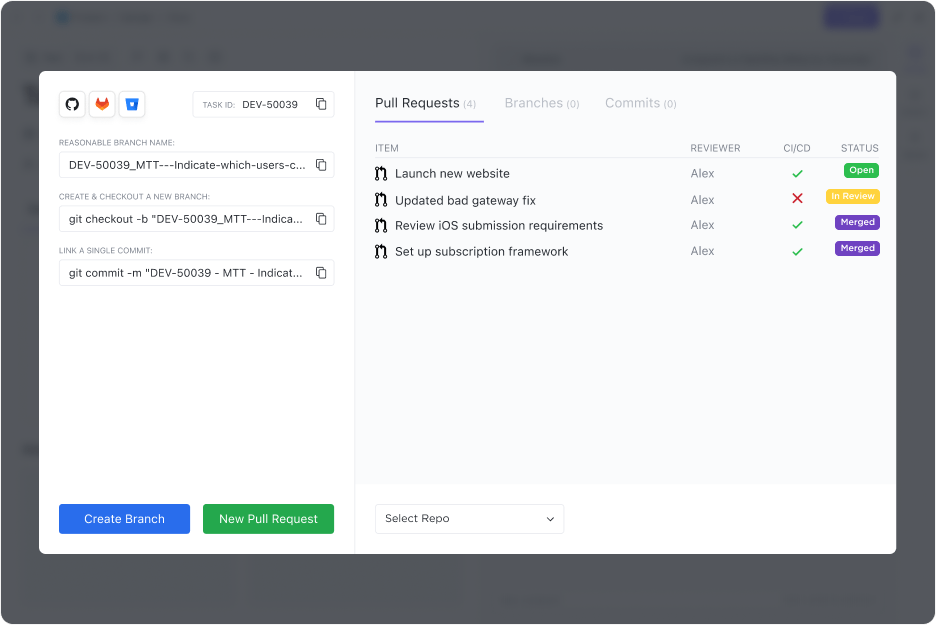
9. Continuous improvement and innovation for the whole business
Regardless of industry, fostering a culture of perpetual improvement is commendable. It allows you to reach, maintain, and enhance operational excellence. 📈
The first step to achieving these outcomes is progress and performance monitoring. You should define and track KPIs and collect user feedback from the start. You can then analyze this data to identify bottlenecks, shaping your future decision-making and goal setting.
Considering continuous improvement gateways is an excellent long-term goal as doing so will expand your problem-solving capabilities and make your IT team resilient.
10. Sustainability as part of your long-term IT objectives
Environmental concerns are becoming more prevalent, putting pressure on companies to be socially responsible. ♻️
The IT industry is no exception. IT companies and departments can reduce their environmental impact in many ways. Some goals to consider include:
- Encouraging remote work: Reducing commuting to lower the carbon footprint
- Embracing the circular economy: Reusing, repairing, and recycling items to maximize efficient resource use and minimize waste
- Switching to eco-friendly tech and manufacturing: Using hardware and equipment that has optimal energy efficiency ratings and certifications
- Investing in renewable sources: Leveraging solar or wind power to meet some or all of their energy needs
- Optimizing the development process: Revising your software development practices so that they entail fewer resource-intensive processes
IT KPI Metrics to Track Alongside IT Department’s Goals
While you should measure the progress of your goals as much as possible, you can’t pay attention to everything. You must prioritize tracking certain KPIs that are the most relevant to your current goals. 📚
Below, we’ll list some of the most common types of metrics across IT functions, which may tie into some of the goals we discussed previously:
Operational
To measure operational performance and efficiency, you can use:
- Project success rate: The percentage of projects completed on time, on budget, and within specifications
- Ticket churn: The ratio of total and open tickets, indicating the percentage of incomplete tasks
- Average handle time: How much time does the team or team member usually need to complete a task or resolve a problem
IT systems
Use the following KPIs to monitor the health of your infrastructure and software:
- Uptime vs. downtime: The percentage of time your systems or servers are running vs. not operational
- Server or cloud utilization: The measurement of system performance
- Mean time to repair/recover: How much time the IT team usually needs to resolve system issues
Security
These indicators pertain to your security and data governance measures:
- Recovery time/point objective: The amount of time or data your organization can afford to lose in case of an incident
- Days since last incident: How much time has passed since the last incident, conveying the effectiveness of implemented security strategies
- Number of open vulnerabilities: Used to monitor the exposure to potential threats
- Backup success rate: The percentage of backed-up data and the number of days since the last backup
Financial
If your IT goal is to analyze and cut back on costs, you may track the following metrics:
- IT spend vs. plan: How much of the available IT budget you’re using and whether you’re using it effectively
- Return on investment: The comparison of gains and losses that result from IT investments
- Money saved: The amount of money you’ve saved as a result of cost negotiation, consolidation of tools, and switching to more affordable solutions
Customer service
The metrics below signify the success of your software development and optimization efforts:
- First contact resolution rate: The percentage of problems resolved on the first service desk touchpoint
- User satisfaction and net promoter score: The users’ subjective measure of how content they are with your product or services and how likely they are to recommend it to others
- User onboarding completion rate: The percentage of users that go through with onboarding, indicating how user-friendly your software is
Human resources (HR)
To assess the effectiveness of your IT talent development strategy and collaboration enhancement efforts, use the following metrics:
- Employee satisfaction: The employees’ subjective feelings about their job
- Employee retention rate: The percentage of employees who stay with the organization during a specified period
- Meeting attendance rate: The percentage of employees who were present at meetings, depicting willingness to collaborate and participate
How to Set and Track IT Goals with ClickUp
IT goal setting is a high-stakes, challenging endeavor, but ClickUp makes it as easy as pie. 😍
Let’s see how to make the most of it!
The first step is to write down all your IT goals on the ClickUp Goals page for your Workspace. Add names, deadlines, and assignees, fine-tuning the access permissions for each goal.
Next, break down the goals into measurable Targets. You have four target types at your disposal:
- Numerical
- Monetary
- True or false
- Task targets
You can also drag and drop existing IT department tasks to connect them with goals. Group similar goals into Folders to organize them and make them more manageable. For example, if your overarching business strategy is to launch a new mobile app in the next quarter, all your IT team goals and tasks can be stacked together in a Folder called App launch goals.
You can also identify the key progress areas for your team by adding ClickUp Milestones—tracking small wins keeps your team motivated.
As you and your IT team complete the work, mark tasks as Done and enter your results within the platform. ClickUp will automatically track your progress, conveying it in percentages. You can quickly assess collective and individual progress toward each goal with weekly scorecards.
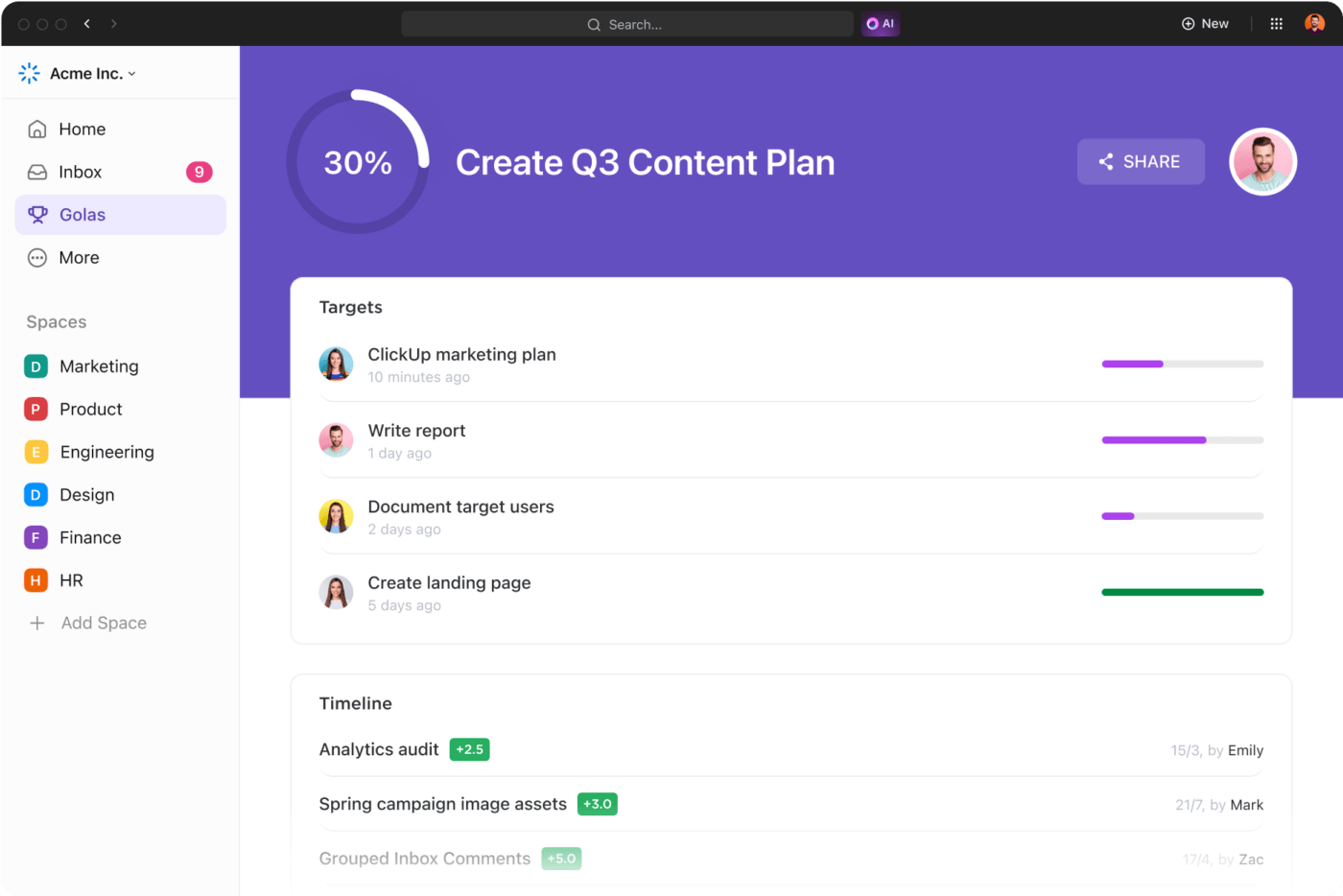
Measure KPIs with ClickUp Dashboards
Build your ClickUp Dashboard and track real-time KPIs for goal progress, performance, team capacity, time-tracking stats, and whatever else is relevant for your team or the project. It has a built-in calculator for complicated KPIs.
Plus, you can personalize your Dashboard with over 50 different cards or reports. Make use of graphical representations like burnup and velocity charts to check the status of your IT goals.
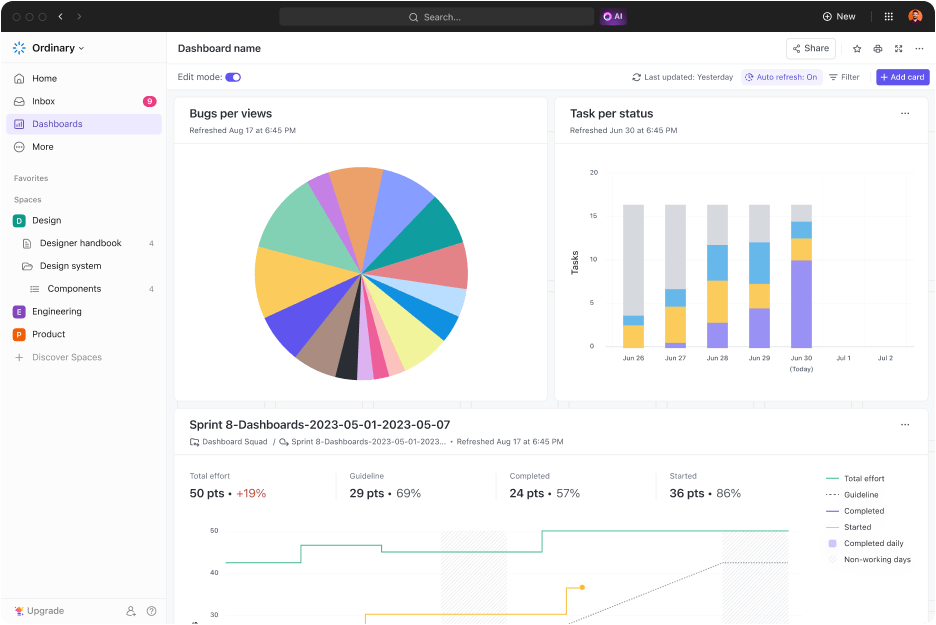
We get it—ClickUp has so many features that it may feel overwhelming to use at first. That’s why we’ve prepared numerous IT templates for different use cases to assist you.
For example, you can use the ClickUp IT Project List Template as an excellent starting point for any project. From monitoring task deadlines to allocating resources, it can help you get all your projects in order.
The ClickUp IT Roadmap Template is another perfect beginner-friendly tool for strategic planning and goal setting. This IT roadmap template helps you design your entire IT itinerary on an interactive timeline, all fully adjustable to changing business needs. 🥳
Set and Surpass Your IT Department Goals with ClickUp
Goal setting must be followed by extensive planning and progress tracking. Thankfully, a tool such as ClickUp can make all of these steps easily surmountable. Sign up for ClickUp and let it support you throughout your strategic planning efforts and beyond. ❣️







